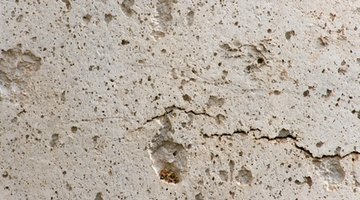How to Repair Spalled Concrete Basement Walls
Spalling is a condition wherein your concrete develops a series of scales or large concrete chips. The spalled surface appears to crumble away from the surrounding concrete. Spalling is generally caused by carbonation of the concrete where carbon dioxide reacts to chemicals within the concrete.

The steel reinforcing bars within the concrete begin to corrode and expand, causing the breakage on the surface concrete. If caught early, spalling can be repaired, removing the need for complete concrete replacement.
Things You Will Need
- Cold chisel
- Hammer
- Circular saw
- Wire brush
- Anti-rust paint
- Paint brush
- Epoxy adhesive
- Concrete mix
- Water
- Bucket
- Drill
- Paddle bit
- Steel trowel
- Plastic sheet
- Mist spray bottle
-
Remove any loose concrete from the spalled surface. Chipped or splintered pieces can be removed using a cold chisel and hammer.
-
Cut a square around the spalled concrete three-eighth of an inch deep using a circular saw.
-
Use the chisel and hammer to break away the concrete contained in the cut area. Expose the reinforcing bars beneath the surface of the concrete and break away any concrete attached to the bars.
-
Brush any rust away from the bars using a wire brush. Examine the ends of the bars still covered in concrete. If the rust continues, cut and clear away the concrete until you reach an unrusted section.
-
Paint the rust-cleared bars with an anti-rust paint. Use two coats of paint applied 10 minutes apart to provide adequate rust protection.
-
Brush a layer of epoxy adhesive to the cleared concrete surface. Allow the adhesive to dry until it’s tacky but not wet. The adhesive will help to create a bond between the old concrete and the new.
-
Mix a batch of concrete in a large bucket. Use a permeable concrete that allows the concrete to breathe and prevent further spalling from trapped water. The concrete should be mixed thickly enough to not sag when placed onto the vertical surface of the wall. Use a drill with a paddle bit to mix the concrete.
-
Fill the hole in the concrete with the new concrete mix using a trowel. Pack the hole tightly, leaving no gaps that may weaken the wall.
-
Use the trowel to smooth the surface of the concrete patch with the surrounding surface of the wall.
-
Cover the new concrete with a plastic sheet to keep the water in the concrete from evaporating too quickly as the concrete cures. Lift the sheet after 48 hours and spray the concrete with a fine mist of water to ensure that it remains wet enough. Remove the sheet after two weeks and then allow the concrete to cure completely for another week to 10 days.
Warning
Protective work gloves, safety goggles and a face mask should be worn when working with concrete to protect from inhalation and chemically induced skin surface burns.
The Drip Cap
- Spalling is a condition wherein your concrete develops a series of scales or large concrete chips.
- Use the chisel and hammer to break away the concrete contained in the cut area.
- Brush any rust away from the bars using a wire brush.
- If the rust continues, cut and clear away the concrete until you reach an unrusted section.
- The concrete should be mixed thickly enough to not sag when placed onto the vertical surface of the wall.
References
Resources
Writer Bio
Larry Simmons is a freelance writer and expert in the fusion of computer technology and business. He has a B.S. in economics, an M.S. in information systems, an M.S. in communications technology, as well as significant work towards an M.B.A. in finance. He's published several hundred articles with Demand Studios.
Photo Credits
- grey concrete image by amlet from Fotolia.com
- grey concrete image by amlet from Fotolia.com
More Articles



